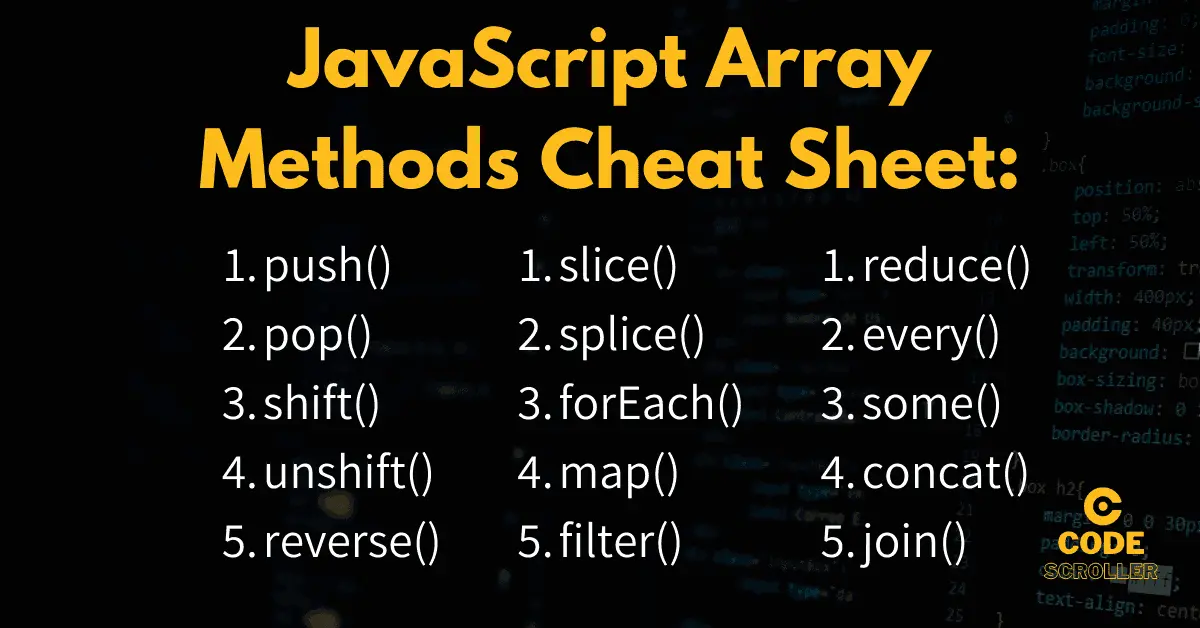Hi, Developers! If you are searching the How Many Ways to Create Array in JavaScript then you have landed at the right place. Whether you’re a beginner or an experienced one, this will help you to create or declare the Array in many ways.
In JavaScript, there are multiple ways to create arrays, each with its own syntax and use cases. Understanding these different methods is essential for effectively working with arrays and optimizing your JavaScript code.
In this article, you will see the various ways to create arrays in JavaScript, including array literals, the Array constructor, Array.from(), and many more. By the end, you’ll have a comprehensive understanding of the options available for creating arrays and be equipped to choose the most appropriate method based on your specific requirements.
5 Different Ways to Create Arrays in JavaScript.
JavaScript has 5 methods to create an Array. Let’s explore all of the Array creation technics:
- Array Literals
- The Array Constructor
- Array.from()
- Array.of()
- Array.prototype Methods
1. How to Create/Declare an Array with Array Literal Syntax.
Array Literals in JavaScript provide a concise and straightforward way to create arrays. They involve enclosing the array elements within square brackets []. This method is widely used due to its simplicity and readability. Let’s explore array literals in detail with an example:
Example-1:
const numbers = [2, 3, 4, 5, 6];
In the example above, we create an array called numbers using an array literal. It has five elements: 2, 3, 4, 5, and 6. A comma separates each element.
In JavaScript Array literals allow you to store elements of any data type, including numbers, strings, objects, null, undefined or even other arrays. Here’s an example of an array literal with different data types:
Example-2:
const mixedArray = [1, 'two', true, { name: 'Tanu Singh' }];
In this case, the ‘mixedArray’ contains elements of different types: the number 1, the string ‘two’, the boolean value true, and an object with a name property.
It’s worth noting that array literals also support expressions to define the array elements. Here’s an example:
Example-3:
const length = 3; const dynamicArray = [1, 2, length * 3];
In the above example, the ‘dynamicArray’ contains three elements: 1, 2, and the result of the expression length * 3 which is 9. The output of the example is [1,2,9]
Array literals are a powerful and widely used method for creating arrays in JavaScript. They offer a straightforward syntax and are ideal for cases where you have a predefined set of elements to initialize an array.
You can also scroll these JavaScript concepts:
- 100+ JavaScript Tricky Questions
- Truthy and Falsy Values in JavaScript Detail Explanation
- Javascript String Methods Cheat Sheet
- 12 Tricks To Write Less JavaScript
2. How to Create an Array using Array Constructor Syntax?
The Array constructor in JavaScript provides a way to create arrays by using the new keyword. It allows you to create an array with specified elements as arguments passed to the constructor.
However, it is worth noting that using array literals ([]) is generally preferred over the Array constructor for creating arrays due to its simplicity and readability.
Here is a detailed explanation of the Array constructor with an example:
The syntax for using the Array constructor is as follows:
new Array(elem0, elem1, ..., elemN)
Where elem0, elem1, …, elemN are optional arguments representing the elements of the array.
Example-1:
const numbers = new Array(1, 2, 3, 4, 5);
console.log(numbers); // Output: [1, 2, 3, 4, 5]
const fruits = new Array('apple', 'banana', 'orange');
console.log(fruits); // Output: ['apple', 'banana', 'orange']
In the first example, we create an array called numbers using the Array constructor with numeric elements. The resulting array contains the elements 1, 2, 3, 4, and 5.
In the second example, we create an array called fruits using the Array constructor with string elements. The resulting array contains the elements ‘apple’, ‘banana’, and ‘orange’.
It’s important to note that when using the Array constructor with a single numeric argument, it defines the length of the array rather than creating an array with that single element.
Example-2:
const singleElementArray = new Array(5); // Output: [5]
In this example, we create an array called ‘singleElementArray’ with a single argument of 5. This results in an array with a length of 5, but all elements are initially empty. The [empty × 5] output indicates the presence of 5 empty slots in the array.
While the Array constructor can be useful in certain scenarios, it’s important to be cautious when using it. Keep in mind that the Array literal notation ([]) is generally more concise and preferred for creating arrays in most cases.
3. How to Create an Array using Array.from() method?
Array.from() is another technic to create an array in JavaScript. To create an array using the Array.from() method, you need to provide an iterable object or an array-like object as the first argument. The Array.from() method creates a new array instance from that object.
Here’s the basic syntax of the Array.from() method:
Syntax
Array.from(iterable, mapFunction, thisValue)
Let’s go through each argument step by step:
- iterable: This argument represents the object to be converted into an array. It can be an iterable object like a string, an array, a Map, or a Set, or an array-like object such as a NodeList or an arguments object.
- mapFunction (optional): This argument is an optional mapping function that can be used to manipulate each element of the resulting array. It is executed for each element in the iterable, and the returned value is included in the new array.
- thisValue (optional): This argument is the value to be used as this when executing the mapFunction. It is optional and not commonly used.
Example 1: Converting a string to an array
const str = 'Hello'; const arr = Array.from(str); console.log(arr); // Output: ['H', 'e', 'l', 'l', 'o']
Example 2: Creating an array using NodeList.
const nodeList = document.querySelectorAll('p');
const arr = Array.from(nodeList);
console.log(arr);
Example 3: Using a mapping function
const str = 'Hello'; const arr = Array.from(str, (char) => char.toUpperCase()); console.log(arr); // Output: ['H', 'E', 'L', 'L', 'O']
In the last example, we pass a mapping function that converts each character to uppercase using toUpperCase() method.
By using the Array.from() method, you can create arrays from various iterable or array-like objects and perform additional transformations if needed.
4. How to Create an Array using Array.of() method?
To create an array using the Array.of() method, you can simply pass the elements you want to include in the array as arguments. The Array.of() method creates a new array instance with the specified elements.
Here’s the basic syntax of the Array.of() method:
Array.of(element1, element2, ..., elementN)
Let’s go through an example to see how to use the Array.of() method:
const arr = Array.of(1, 2, 3, 4, 5); console.log(arr); // Output: [1, 2, 3, 4, 5]
In the above example, we pass the numbers 1, 2, 3, 4, and 5 as arguments to the Array.of() method. It creates a new array containing those elements.
The Array.of() method is particularly useful when you want to create an array with a small number of elements or when you want to ensure that the argument values are treated as individual elements of the array, rather than being interpreted as the length of the array (as in the case of Array() constructor).
Here’s an example to demonstrate the difference between Array() constructor and Array.of() method:
const arr1 = Array(5); console.log(arr1); // Output: [empty × 5] const arr2 = Array.of(5); console.log(arr2); // Output: [5]
In the above example, Array(5) creates an array with a length of 5, but the array is initially empty. On the other hand, Array.of(5) creates an array with a single element 5.
So, by using the Array.of() method, you can easily create an array by passing the desired elements as arguments, ensuring that they are treated as individual elements of the array.
5. How to Create an Array using Array.prototype methods?
To create an array using Array.prototype methods, you can utilize several built-in methods available on the Array prototype. Here are a few commonly used methods for creating arrays:
a) Array.prototype.concat():
This method is used to concatenate two or more arrays or values into a new array.
Example:
const arr1 = [1, 2]; const arr2 = [3, 4]; const concatenatedArr = arr1.concat(arr2); console.log(concatenatedArr); // Output: [1, 2, 3, 4]
b) Array.prototype.push():
This method is used to add elements to the end of an array and returns the new length of the array.
Example:
const arr = [1, 2]; arr.push(3, 4); console.log(arr); // Output: [1, 2, 3, 4]
c) Array.prototype.pop():
This method is used to remove elements from the end of an array and returns the removed element.
Example:
const arr = [1, 2]; arr.pop(); console.log(arr); // Output: [1]
d) Array.prototype.unshift():
This method is used to add elements to the beginning of an array and returns the new length of the array.
Example:
const arr = [3, 4]; arr.unshift(1, 2); console.log(arr); // Output: [1, 2, 3, 4]
e) Array.prototype.slice():
This method creates a new array by extracting a portion of an existing array.
Example
const arr = [1, 2, 3, 4]; const slicedArr = arr.slice(1, 3); console.log(slicedArr); // Output: [2, 3]
These are just a few examples of Array.prototype methods that can be used to create and manipulate arrays. Depending on your specific use case, there are many other methods available that you can explore in the JavaScript documentation to achieve the desired array creation and manipulation.
FAQs (Frequently Asked Questions) – “How Many Ways to Create Array in JavaScript”
Q) What is the most common and basic way to create an array in JavaScript?
Ans) The most common and basic way to create an array in JavaScript is by using array literals, denoted by square brackets [], where you list the elements inside.
Q) Are there any pitfalls when using the Array constructor to create an array?
Ans) Yes, there is a potential pitfall when using the Array constructor with a single numerical argument. Instead of creating an array with the specified length, it creates an array with one element having that numerical value.
Q) When should I use the Array.from() method to create an array?
Ans) The Array.from() method is useful when you need to create an array from an iterable or array-like object. It allows you to perform transformations during the array creation process.
Q) Which Array.prototype methods can be used to create and manipulate arrays?
Ans) There are several Array.prototype methods that can be used, such as concat(), push(), unshift(), slice(), fill(), and more.
Q) How is the Array.of() method different from using the Array constructor?
The Array.of() method is specifically designed to create an array with a small number of elements. It ensures that the arguments provided are treated as individual elements, rather than being interpreted as the length of the array.
Conclusion:
JavaScript offers multiple ways to create arrays, each serving different purposes depending on the specific requirements of your code. Here are the main methods discussed in the article “How Many Ways to Create Array in JavaScript“:
Array literal ([]): The simplest and most common way to create an array is by using square brackets and listing the elements inside. This method is straightforward and efficient when you know the elements beforehand.
Array constructor (new Array()): The Array constructor allows you to create an array by providing the desired length or a list of elements as arguments.
Array.from(): The Array.from() method allows you to create an array from an iterable or array-like object. It provides flexibility and the ability to perform transformations during the array creation process.
Array.of(): The Array.of() method is useful when you want to create an array with a small number of elements or when you want to ensure that the arguments are treated as individual elements, rather than as the length of the array.
Array.prototype methods: The Array.prototype provides a variety of methods like concat(), push(), unshift(), slice(), fill(), and more, which can be used to create and manipulate arrays based on specific requirements.
By understanding these different approaches, you can choose the most suitable method to create arrays in JavaScript, considering factors such as simplicity, performance, and the specific data you need to work with. Being familiar with these options will empower you to write more efficient and concise code when working with arrays in JavaScript.




